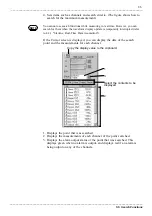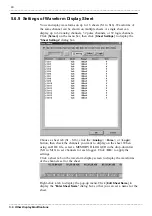
34
_____________________________________________________________________________________________
5.5 Search Functions
______________________________________________________________________________________________
5.5.2 Other Search Functions
Search marker
1.
2.
3.
You can set up to 4 search criteria.
4.
In addition to jumping to event markers, you can display a waveform by
jumping to points that fulfill the waveform conditions that you specify.
A search marker is displayed in the search position.
To display the Settings screen for search criteria, click <
Search
> on the left
of the Information screen.
1. Click here to search for a point. To jump to a point that fulfills the search
criteria that you have set and display the relevant waveform, click here to
search the previous screen (the next screen to the left). Each time you
click here, the previous screen is searched.
2. Click here to search for a point. Each time you click here, the next screen
(the next screen to the right) is searched for points that fulfill the search
criteria that you have set, and if any points are found the screen jumps to
that point and displays the relevant waveform.
3. Selects a search mode. You can select from the following 9 search modes:
TIME AXIS: Jumps to the set date.
Max Pos: Jumps to the maximum measurement value of the channel
being searched.
Min Pos: Jumps to the minimum measurement value of the channel
being searched.
Peaks: Jumps to the peaks of the channel being searched.
Valleys: Jumps to the valleys of the channel being searched.
Alarm: Jumps to the set alarm output condition.
If you select All Alarms in Alarm Settings, display jumps to
the positions on all alarm channels where even one alarm
has been output.
Level: Jumps to the point at which the waveform rises above or
falls below the set level for the channel being searched.
Window: Jumps to a point within the set upper and lower limits (or
to a point outside the range) of the channel being searched.
Slope: Jumps to the point of increase for the inclination
(inclination per sampling interval) of the set waveform (or
the point of decrease) of the channel being searched.






























